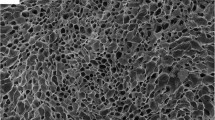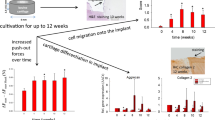Abstract
Bacterial nanocellulose (BNC), synthesized by the bacterium Gluconacetobacter xylinus, is composed of highly hydrated fibrils (99 % water) with high mechanical strength. These exceptional material properties make BNC a novel biomaterial for many potential medical and tissue engineering applications. Recently, BNC with cellulose content of 15 % has been proposed as an implant material for auricular cartilage replacement, since it matches the mechanical requirements of human auricular cartilage. This study investigates the biocompatibility of BNC with increased cellulose content (17 %) to evaluate its response in vitro and in vivo. Cylindrical BNC structures (Ø48 × 20 mm) were produced, purified in a built-in house perfusion system, and compressed to increase the cellulose content in BNC hydrogels. The reduction of endotoxicity of the material was quantified by bacterial endotoxin analysis throughout the purification process. Afterward, the biocompatibility of the purified BNC hydrogels with cellulose content of 17 % was assessed in vitro and in vivo, according to standards set forth in ISO 10993. The endotoxin content in non-purified BNC (2,390 endotoxin units (EU)/ml) was reduced to 0.10 EU/ml after the purification process, level well below the endotoxin threshold set for medical devices. Furthermore, the biocompatibility tests demonstrated that densified BNC hydrogels are non-cytotoxic and cause a minimal foreign body response. In support with our previous findings, this study concludes that BNC with increased cellulose content of 17 % is a promising non-resorbable biomaterial for auricular cartilage tissue engineering, due to its similarity with auricular cartilage in terms of mechanical strength and host tissue response.








Similar content being viewed by others
References
Ahrem H, Pretzel D, Endres M, Conrad D, Courseau J, Muller H, Jaeger R, Kaps C, Klemm DO, Kinne RW (2014) Laser-structured bacterial nanocellulose hydrogels support ingrowth and differentiation of chondrocytes and show potential as cartilage implants. Acta Biomater 10(3):1341–1353. doi:10.1016/j.actbio.2013.12.004
Almeida CR, Serra T, Oliveira MI, Planell JA, Barbosa MA, Navarro M (2014) Impact of 3-D printed PLA- and chitosan-based scaffolds on human monocyte/macrophage responses: unraveling the effect of 3-D structures on inflammation. Acta Biomater 10(2):613–622. doi:10.1016/j.actbio.2013.10.035
Anderson JM (1993) Mechanisms of inflammation and infection with implanted devices. Cardiovasc Pathol 2(3):33S–41S
Anderson JM (2001) Biological responses to materials. Annu Rev Mater Res 31(1):81–110. doi:10.1146/annurev.matsci.31.1.81
Anderson JM, Langone JJ (1999) Issues and perspectives on the biocompatibility and immunotoxicity evaluation of implanted controlled release systems. J Control Release 57(2):107–113
Anderson JM, Shive MS (1997) Biodegradation and biocompatibility of PLA and PLGA microspheres. Adv Drug Deliv Rev 28(1):5–24
Andersson J, Stenhamre H, Bäckdahl H, Gatenholm P (2010) Behavior of human chondrocytes in engineered porous bacterial cellulose scaffolds. J Biomed Mater Res A 94(4):1124–1132. doi:10.1002/jbm.a.32784
Andrade FK, Alexandre N, Amorim I, Gartner F, Mauricio AC, Luis AL, Gama M (2013) Studies on the biocompatibility of bacterial cellulose. J Bioact Compat Polym 28(1):97–112. doi:10.1177/0883911512467643
Bäckdahl H, Esguerra M, Delbro D, Risberg B, Gatenholm P (2008) Engineering microporosity in bacterial cellulose scaffolds. J Tissue Eng Regent Med 2(6):320–330. doi:10.1002/Term.97
Bäckdahl H, Helenius G, Bodin A, Nannmark U, Johansson BR, Risberg B, Gatenholm P (2006) Mechanical properties of bacterial cellulose and interactions with smooth muscle cells. Biomaterials 27(9):2141–2149
Bermueller C, Schwarz S, Elsaesser AF, Sewing J, Baur N, Av B, Scheithauer M, Notbohm H, Rotter N (2013) Marine collagen scaffolds for nasal cartilage repair: prevention of nasal septal perforations in a new orthotopic rat model using tissue engineering techniques. Tissue Eng A 19(19–20):2201–2214
Bodin A, Bharadwaj S, Wu SF, Gatenholm P, Atala A, Zhang YY (2010) Tissue-engineered conduit using urine-derived stem cells seeded bacterial cellulose polymer in urinary reconstruction and diversion. Biomaterials 31(34):8889–8901. doi:10.1016/J.Biomaterials.2010.07.108
Brown RM Jr, Willison JH, Richardson CL (1976) Cellulose biosynthesis in Acetobacter xylinum: visualization of the site of synthesis and direct measurement of the in vivo process. Proc Natl Acad Sci U S A 73(12):4565–4569
Deinema M, Zevenhuizen LPTM (1971) Formation of cellulose fibrils by gram-negative bacteria and their role in bacterial flocculation. Arch Mikrobiol 78(1):42–57. doi:10.1007/bf00409087
FDA US (June 2012) Guidance for industry—pyrogen and endotoxins testing. In: Services USDoHH (ed). U.S. Food and Drug Administration, Silver Spring, p 11
Feldmann EM, Sundberg J, Bobbili B, Schwarz S, Gatenholm P, Rotter N (2013) Description of a novel approach to engineer cartilage with porous bacterial nanocellulose for reconstruction of a human auricle. J Biomater Appl. doi:10.1177/0885328212472547
Fink HP, Purz HJ, Bohn A, Kunze J (1997) Investigation of the supramolecular structure of never dried bacterial cellulose. Macromol Symp 120:207–217. doi:10.1002/Masy.19971200121
Gatenholm P, Berry J, Rojas R, Sano MB, Davalos RV, Johnson K, Rourke LO (2012) Bacterial nanocellulose biomaterials with controlled architecture for tissue engineering scaffolds and customizable implants. In: Gama M, Gatenholm P, Klemm D (eds) Bacterial Nanocellulose: a sophisticated multifunctional material. Perspectives in Nanotechnology. CRC Press, pp 197-216
Gea S, Reynolds CT, Roohpour N, Wirjosentono B, Soykeabkaew N, Bilotti E, Peijs T (2011) Investigation into the structural, morphological, mechanical and thermal behaviour of bacterial cellulose after a two-step purification process. BioresourTechnol 102(19):9105–9110. doi:10.1016/j.biortech.2011.04.077
Grobelski B, Wach RA, Adamus A, Olejnik AK, Kowalska-Ludwicka K, Kolodziejczyk M, Bielecki S, Rosiak JM, Pasieka Z (2014) Biocompatibility of modified bionanocellulose and porous poly(e-caprolactone) biomaterials. Int J Polym Mater Polym Biomater 63(10):518–526. doi:10.1080/00914037.2013.854223
Heine H, Rietschel ET, Ulmer AJ (2001) The biology of endotoxin. Mol Biotechnol 19(3):279–296. doi:10.1385/MB:19:3:279
Helenius G, Bäckdahl H, Bodin A, Nannmark U, Gatenholm P, Risberg B (2006) In vivo biocompatibility of bacterial cellulose. J Biomed Mater Res A 76(2):431–438. doi:10.1002/jbm.a.30570
Hold GL, Bryant CE (2011) The molecular basis of lipid A and Toll-like receptor 4 interactions. In: Valvano MA (ed) Knirel YA. Bacterial Lipopolysaccharides, Springer Vienna, pp 371–387
Jones KS (2008) Effects of biomaterial-induced inflammation on fibrosis and rejection. Semin Immunol 20(2):130–136. doi:10.1016/j.smim.2007.11.005
Klechkovskaya VV, Baklagina YG, Stepina ND, Khripunov AK, Buffat PA, Suvorova EI, Zanaveskina IS, Tkachenko AA, Gladchenko SV (2003) Structure of cellulose Acetobacter xylinum. Crystallogr Rep 48(5):755–762. doi:10.1134/1.1612596
Klemm D, Ahrem H, Kramer F, Fried W, Wippermann J, Kinne RW (2012) Bacterial nanocellulose hydrogels designed as bioartificial medical implants. In: Gama M, Gatenholm P, Klemm D (eds) Bacterial Nanocellulose: a sophisticated multifunctional material. Perspectives in Nanotechnology. CRC Press, pp 175-196
Klemm D, Schumann D, Udhardt U, Marsch S (2001) Bacterial synthesized cellulose—artificial blood vessels for microsurgery. Prog Polym Sci 26(9):1561–1603
Kondo T, Nojiri M, Hishikawa Y, Togawa E, Romanovicz D, Brown RM (2002) Biodirected epitaxial nanodeposition of polymers on oriented macromolecular templates. Proc Natl Acad Sci U S A 99(22):14008–14013. doi:10.1073/pnas.212238399
Kotzar G, Freas M, Abel P, Fleischman A, Roy S, Zorman C, Moran JM, Melzak J (2002) Evaluation of MEMS materials of construction for implantable medical devices. Biomaterials 23(13):2737–2750
Kowalska-Ludwicka K, Cala J, Grobelski B, Sygut D, Jesionek-Kupnicka D, Kolodziejczyk M, Bielecki S, Pasieka Z (2013) Modified bacterial cellulose tubes for regeneration of damaged peripheral nerves. Arch Med Sci 9(3):527–534. doi:10.5114/aoms.2013.33433
Mansikkamäki P, Lahtinen M, Rissanen K (2005) Structure changes of cellulose crystallites induced by mercerization in different solvent system; determined by powder X-ray diffraction method. Cellulose 12:233–242
Martinez H, Brackmann C, Enejder A, Gatenholm P (2012) Mechanical stimulation of fibroblasts in micro-channeled bacterial cellulose scaffolds enhances production of oriented collagen fibers. J Biomed Mater Res A 100(4):948–957. doi:10.1002/jbm.a.34035
Martinez-Sanz M, Olsson RT, Lopez-Rubio A, Lagaron JM (2011) Development of electrospun EVOH fibres reinforced with bacterial cellulose nanowhiskers. Part I: Characterization and method optimization. Cellulose 18(2):335–347. doi:10.1007/S10570-010-9471-1
Matsuoka MTT, Matsushita K, Adachi O, Yoshinaga F (1996) A synthetic medium for bacterial cellulose production by Acetobacter xylinum subsp. sucrofermentation. Biosci Biotechnol Biochem 60:575–579
Mello LR, Feltrin LT, Neto PTF, Ferraz FAP (1997) Duraplasty with biosynthetic cellulose: an experimental study. J Neurosurg 86(1):143–150. doi:10.3171/Jns.1997.86.1.0143
Moharram MA, Mahmoud OM (2007) X-ray diffraction methods in the study of the effect of microwave heating on the transformation of cellulose I into cellulose II during mercerization. J Appl Polym Sci 105(5):2978–2983. doi:10.1002/App.26580
Nimeskern L, Martínez Ávila H, Sundberg J, Gatenholm P, Müller R, Stok KS (2013) Mechanical evaluation of bacterial nanocellulose as an implant material for ear cartilage replacement. J Mech Behav Biomed 22:12–21. doi:10.1016/j.jmbbm.2013.03.005
O'Sullivan A (1997) Cellulose: the structure slowly unravels. Cellulose 4(3):173–207. doi:10.1023/a:1018431705579
Robitaille R, Dusseault J, Henley N, Desbiens K, Labrecque N, Halle JP (2005) Inflammatory response to peritoneal implantation of alginate-poly-L-lysine microcapsules. Biomaterials 26(19):4119–4127. doi:10.1016/j.biomaterials.2004.10.028
Rosen CL, Steinberg GK, DeMonte F, Delashaw JB Jr, Lewis SB, Shaffrey ME, Aziz K, Hantel J, Marciano FF (2011) Results of the prospective, randomized, multicenter clinical trial evaluating a biosynthesized cellulose graft for repair of dural defects. Neurosurgery 69(5):1093–1103. doi:10.1227/NEU.0b013e3182284aca
Sandle T (2011) A practical approach to depyrogenation studies using bacterial endotoxin. J GXP Compliance 15(4):90–96
Sano MB, Rojas AD, Gatenholm P, Davalos RV (2010) Electromagnetically controlled biological assembly of aligned bacterial cellulose nanofibers. Ann Biomed Eng 38(8):2475–2484. doi:10.1007/S10439-010-9999-0
Segal L, Creely JJ, Martin AE, Conrad CM (1959) An empirical method for estimating the degree of crystallinity of native cellulose using the X-ray diffractometer. Text Res J 29(10):786–794. doi:10.1177/004051755902901003
Silipo A, Molinaro A (2011) Lipid A structure. In: Valvano MA (ed) Knirel YA. Bacterial Lipopolysaccharides, Springer Vienna, pp 1–20
Svensson A, Nicklasson E, Harrah T, Panilaitis B, Kaplan DL, Brittberg M, Gatenholm P (2005) Bacterial cellulose as a potential scaffold for tissue engineering of cartilage. Biomaterials 26(4):419–431
White DG, Brown RM (1989) Prospects for the commercialization of the biosynthesis of microbial cellulose. In: Schuerech C (ed) Cellulose and Wood-Chemistry and Technology. John Wiley & Sons, New York, pp 573–590
Williams KL (2007a) Depyrogenation validation, pyroburden and endotoxin removal. In: Williams KL (ed) Endotoxins. Drugs and the Pharmaceutical Sciences. CRC Press, pp 301-327
Williams KL (2007b) Fever and the host response. In: Williams KL (ed) Endotoxins. Drugs and the Pharmaceutical Sciences. CRC Press, pp 47-66
Zaborowska M, Bodin A, Bäckdahl H, Popp J, Goldstein A, Gatenholm P (2010) Microporous bacterial cellulose as a potential scaffold for bone regeneration. Acta Biomater 6(7):2540–2547. doi:10.1016/j.actbio.2010.01.004
Acknowledgments
The authors acknowledge ERANET/EuroNanoMed (EAREG-406340-131009/1) for funding this work; Veronika Fuss and Anette Jork at Cell Med AG, Alzenau, Germany, for the support with histopathological evaluation and cytotoxicity testing; Alexander Elsaesser at Ulm University Medical Center, Ulm, Germany, for helping with the animal study; and Johan Sundberg, Anne Wendel, and Professor Vratislav Langer at Chalmers University of Technology, Gothenburg, Sweden, for the SEM analysis, ESCA, and XRD measurements, respectively.
Author information
Authors and Affiliations
Corresponding author
Rights and permissions
About this article
Cite this article
Martínez Ávila, H., Schwarz, S., Feldmann, EM. et al. Biocompatibility evaluation of densified bacterial nanocellulose hydrogel as an implant material for auricular cartilage regeneration. Appl Microbiol Biotechnol 98, 7423–7435 (2014). https://doi.org/10.1007/s00253-014-5819-z
Received:
Revised:
Accepted:
Published:
Issue Date:
DOI: https://doi.org/10.1007/s00253-014-5819-z




